Sieves and Particle Size Reduction in feed industry processing
Sieves & Particle Size Reduction
Published: October 15, 2008
By: Jonathan Bradshaw - Published on Grain & Feed Milling Technology magazine (January 2008) - Article courtesy of Perendale Publishers
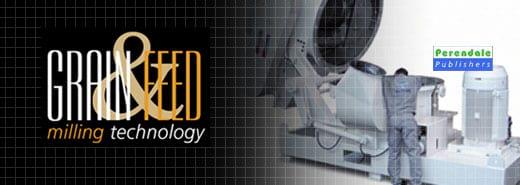
The sifter floor tends to be out of sight and out of mind in many flour mills, getting attention only when the mill is stopped. But the sifter floor is just as important as the roller floor and proper sifter maintenance is a key element of mill performance, with as much influence on extraction, ash and colour as a rollermill or purifier setting.

Over the years, sifters have not progressed regularly. We saw the jump from centrifugal reel sifting to plansifters. We saw the drawer type sifter come and go, with most, if not all millers favoring the use of square sieve plansifters, pioneered by the likes of SMico and Great Western. These engineers used wood as their main material to create the sifter frame. Today we see aluminium and stainless steel preferred to wood. The main reason is that metals do not splinter and create a potential contaminant in the finished product.
Similarly, we have seen the recent introduction of plastic sieves within the sifter, introduced by Satake but now offered by other engineers such as Buhler as well. These days, the customer demands a riskfree product, and although customers are not stipulating the use of nylon sieves, they are displaying a preference, particularly in new installations. Sanitation becomes a secondary issue when all the other parts of the sifter that come into contact with the product are made of either stainless steel or other synthetic materials. Plastic minimizes condensation and mould growth, both of which are important considerations in tropical climates such as Indonesia or Ghana.
The molded sieve frames minimize accumulation of material and the interlocking aspect of both the Satake and Buhler sieves eliminates the need for felt between sieve frames to prevent product leakage from between the frames into the gravity channels. This reduces cross contamination significantly. The use of plastic cleaners and adhesives all adds to improved sanitation. Anyone building a new mill today would need to think twice about using timber frames and melamine linings when plastic sieves are available to do the same job.
Other changes in sifter technology relate to construction of the sifters themselves. The use of modular construction techniques makes access to buildings much easier, since individual sifter sections can be taken up into the mill instead of three sections at one time. And modular construction means that sifters with up to 10 sections can now be installed. As a result, the permutations of roll numbers and sifter sections are extremely flexible and with the addition of two high rollermills, some very innovative flows and compact layout designs can be achieved, particularly in mills processing two to four hundred tonnes per day of wheat ground through first break.
Sieve areas have also increased in recent years, although there is a limit to the height of a sifter stack. Building present limitations and safety regulations limit the height at which an operative can work, particularly when using step ladders and manhandling choked sieves from the top of a break or head reduction section. Square area of sieves is improved by using the inner channels as sifting surface in the top scalping sections of break and head reduction passages. This increase has reduced the use of relatively inefficient prebreak scalpers such as le coq sifters.
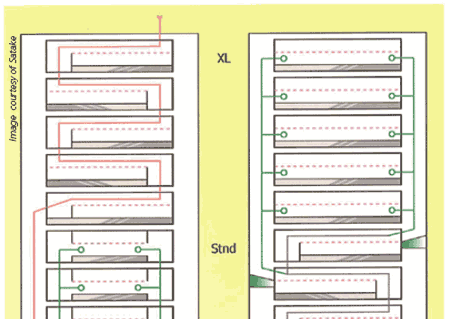
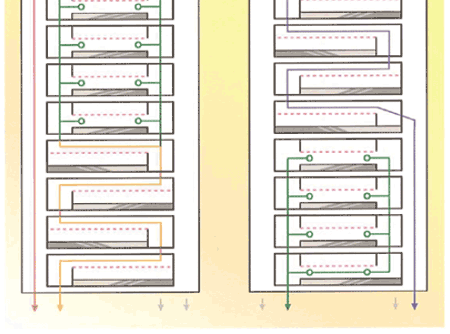
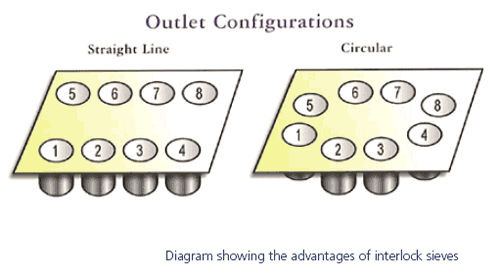
More regular and accurate tension within the sifter box
Clamping mechanisms have been enhanced with the use of compressed air to raise and lower the top clamping boxes on most manufacturers’ sifters. Mainly introduced for safety reasons on taller machines, this allows for more regular and accurate tension within the sifter box. Before such devices were introduced, the strength of the mill operative was the deciding factor. Wasn’t it always Goliath who clamped up the section before David had to unclamp it!
Apart from the use of adhesives to secure sieve clothing to sieve frames, there has been relatively little change to fabrics and wires. Some millers in developing countries prefer to use stainless steel for flour sifting but this is frowned on in Europe for sanitation reasons. Stainless steel does wear better and does not burst as frequently, but it does have drawbacks and fragments of stainless steel are not the best items to have in bakeries.
Particle size reduction also refers to bran finishers, impact detachers and vibro sifters - ancillary machines used for size reduction and separation in preference to plansifters and rollermills that do the bulk of the work.
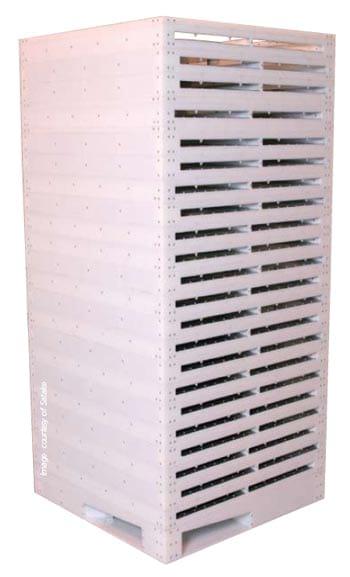
There has been little change in the basic design of these machines. I refer readers back to the days when entoleters were first introduced and their impact on the number of rollermills in a plant. The ability to set rollermills to grind hard and produce a flake, which was then broken down or “disrupted” prior to sifting, had a major effect on flow sheet design. But the basic design of the entoleter has remained unchanged although nowadays there is a preference for in-line machines placed in pneumatic lifts. Harder wearing pins have been adopted and in some cases, the rotational speed has been increased, particularly in soft wheat mills where there is a desire to produce flour with low starch damage.
The need to increase extraction rates brought about the use of bran finishers, which again have not changed significantly since their inception in the form of horizontal beaters and screens. There have been some variations in beater design and screen hole configuration, but the basic principles of operation have remained unchanged.
The use of vibro sifters and quiver sifters has accompanied the use of bran finishers and there is wider use of these sifters to handle filter stocks which tend to be sticky and not easy to dress out on conventional plansifters. Vibro sifters replicate the action of the centrifugal reel sifter, except the element of vibration is introduced, helping to keep the screen clean and free of blind areas.
Quiver sifters are similar in operation but are vertical. Copying the whizzer action of the now defunct washer and whizzer, these are excellent machines for handling filter and other stocks that are difficult to separate.
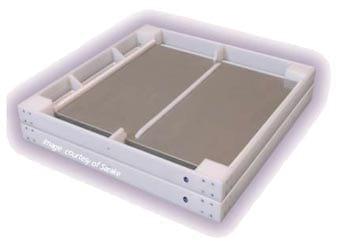
The purist miller, like myself, has long lamented the demise of the scratch system from the modern mill diagram. With purifier passages being limited to coarse and fine semolinas, where they are used at all, there are few places to recover small amounts of “difficult” stocks and it has become the role of the ancillary machine to recover what can be gleaned from stocks otherwise destined for the bran bag. Such machines are more reliable and settings do not drift as they used to with a scratch roll. Feed rates do not affect performance through a vibro sifter as much as variations of feed to a scratch system used to. Little attention needs to be paid each shift to setting up the rolls, although a good miller is one who regularly checks his rollermill setting by hand and eye, rather than watching the ammeter on control room panel.
In the debate about what machines should be used for which purpose, the flow diagram is often neglected. All machines work well if they are correctly sized and applied and positioned correctly in the flow. Today there is a tendency to simply place a machine in the flow without giving enough consideration to its purpose.
For example, branny stocks and coarse materials assist the sifting of more sticky, very fine particle sized filter stocks. I often see mills where badly set pneumatic systems, with lots of cyclone carryover, produce excellent extraction rates and good ash, simply because the combination of particle sizes emanating from the filter allows for better than normal dressing to take place. This comes at the price of higher than normal power costs… but that is not always a reason to change things, particularly when wheat prices are as high as they are today.
There has been little development of the sifter by most milling engineers other than Buhler in recent years. I believe this is due largely to the high cost of development these days. To produce a new machine, or simply to change a design point and then equip a manufacturing facility to produce the new design, does not come cheaply.
Fortunately Buhler sells a large number of machines around the world and development costs can be offset by the number of units sold. Other milling engineers do not have the luxury of high volume sales and to invest heavily in new product development is beyond their budgets. As a direct result, I believe we will see a trend towards more collaboration between milling engineers, whereby companies concentrate on a reduced range of machines but with a greater throughput and consequently, the development of new machines. This could be cost effective for sifters and many other milling machines, although probably not with rollermills. Thus we may see a change in the manufacturing structure of milling equipment and co-operation between companies, exchange of ideas and pooling of resources that will directly influence the next generation of machinery offered to the market.
Similarly, rising wheat prices and the need for improved mill performance will call into question the technical operations of many mills. Attention to detail by operatives, technicians and mill managers will become paramount. Attention to sifter schemes, roll fluting, diagram specifications and use of ancillary machines will also become more relevant, as wheat prices rise but product prices remain relatively inflexible.
Although fluting profiles remain satisfactory for today’s needs, mills that incorporate debranning as part of their milling flow sheet have shown that there is some advantage to be gained, particularly when milling harder wheat, by using differing profiles, in general producing coarser semolinas. Coarser semolinas dress better and at greater throughput than fine materials. Perhaps the next development in sifting technology and the ancillary machines may not be the development of the machines themselves, but the development of factors which affect the shape and size of the material that these machines have to process. Food for thought ?
|
Related topics
Join to be able to comment.
Once you join Engormix, you will be able to participate in all content and forums.
* Required information
Would you like to discuss another topic? Create a new post to engage with experts in the community.
Create a postJavaneh khorasan
17 de enero de 2009
Particle size is very important in pellet physical form and it effects on broiler performance.

6 de enero de 2009
OK the article about Sieves and Particle Size Reduction in feed industry processing
6 de enero de 2009
Good article about Sieves and Particle Size Reduction in feed industry processing; thanks.







